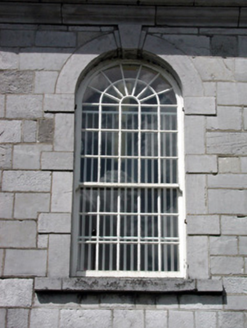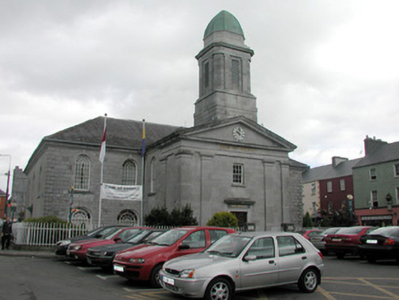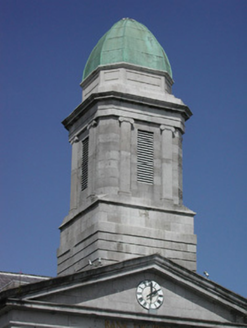Survey Data
Reg No
31817009
Rating
Regional
Categories of Special Interest
Architectural, Artistic, Historical, Social, Technical
Previous Name
Roscommon Courthouse and Market House
Original Use
Market house
Historical Use
Church/chapel
In Use As
Bank/financial institution
Date
1740 - 1760
Coordinates
187441, 264585
Date Recorded
12/08/2003
Date Updated
--/--/--
Description
Detached cruciform two-storey former court house, built 1750, now in use as bank. Hipped slate roof to main block and pitched to entrance and rear blocks. Cast-iron rainwater goods. Cut stone chimneystacks to rear block. Random coursed dressed limestone walls with ashlar quoins, moulded cut stone cornice. Rendered side elevations to main block. Front entrance block with pedimented ashlar façade with paired pilasters, surmounted by stepped square-profile ashlar cupola with domical-vaulted copper-clad roof and with louvers flanked by Ionic pilasters. Back wall of rear block has pediment topped by stone ball finial and has round panel to tympanum, moulded string course with a moulded bracket below. Tooled block-and-start round-headed window surrounds throughout with timber sash windows with tooled stone sills. Windows in back wall of main block are set into two-storey round-headed recesses. Square-headed window over main entrance and oculi in back wall of rear block. Timber panelled entrance door in square-headed opening with moulded cut stone surround and entablature. Round-headed doorway in west side of entrance block. Cast-iron railings surround site with ashlar gate piers to south and west.
Appraisal
Originally built as a rectangular-plan court house in the mid-eighteenth century, this building, having become derelict, was bought by the Parish Priest Fr John Madden in 1829, at the time of Roman Catholic Emancipation. Converted into a Roman Catholic Church, the front and rear additions were erected in 1844. The authority of the building is obvious from its location in the centre of the market square, opposite the former prison. The finely-executed stone of the façade is embellished by the pediments and carved stone dressings such as the Ionic pilasters to the cupola. The building still serves the local community as a bank.





